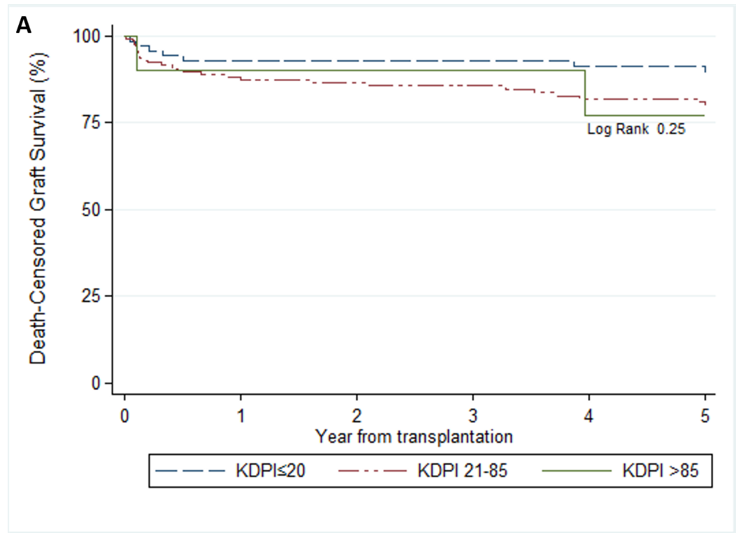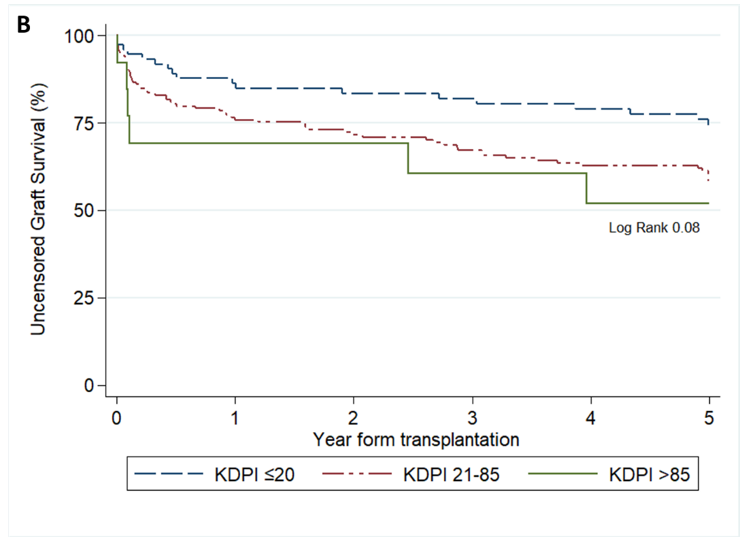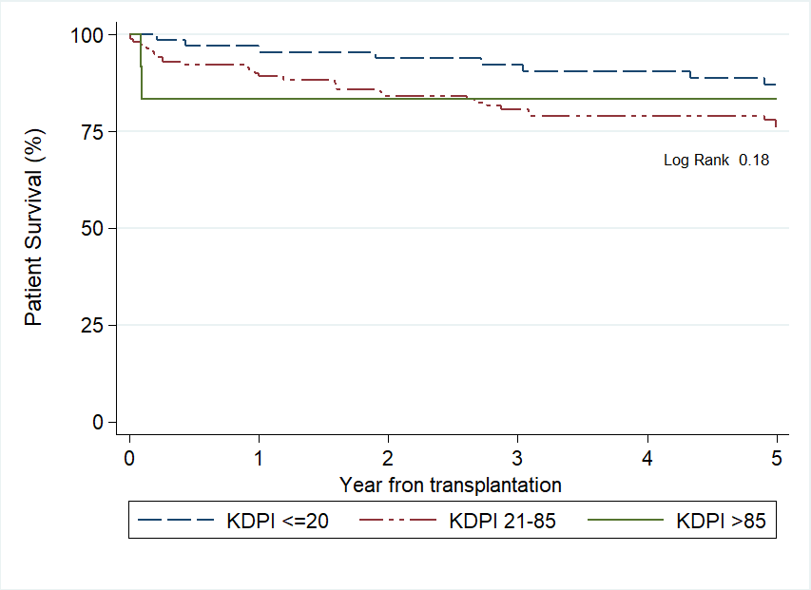Retrospective analysis of the Kidney Donor Profile Index (KDPI) with patient and graft survival at 5 years post transplantation
Laura Nino-Torres1, Alejandro Nino-Murcia2, Andrea Garcia-Lopez 3, Fernando Giron-Luque 2,3.
1General Surgery, Universidad del Rosario, Bogota DC, Colombia; 2Transplant Surgery, Colombiana de Trasplantes, Bogota DC, Colombia; 3Research, Colombiana de Trasplantes, Bogota DC, Colombia
Background: The Kidney Donor Profile Index (KDPI) have demonstrated correlations with patient and graft outcomes1,2. We aimed to evaluate the impact of KDPI on transplantation major outcomes applied to a Colombian cohort.
Materials and methods: We retrospectively assessed 261 adult patients who underwent kidney transplantation (KT) from January 2011 to June 2014 at our center and compared their KDPIs with graft and patient outcomes at 5 years post-transplantation. Kaplan- Meier survival method and Cox analysis were fitted to analyzed the impact of the three KDPI categories on graft and patient outcomes3.
Results and Discussion: A total of 4.9% of transplants were from donors with a KDPI ≥ 85%. There was a significant decrement in renal function with increasing KDPI at 5 years post-transplantation (p< 0.05). The final model indicates that donor diabetes was associated with elevated risk for graft loss (HR 9.3 (CI 2.2-39.4), p=.002) at 5 years post-transplantation. Recipient´s age (HR 2.3 (CI 1.1-4.8), p=.025), history of diabetes (HR 2.5 (CI 1.2-5.2), p=.013), and operating room time (HR 4.9 (CI 1.6-14.6), p=.004) were associated with elevated risk for death at 5 years post-transplantation. KDPI categories were not significantly associated with graft loss or death. Uncensored graft survival at 5 years was 74% for recipients of KDPI score < or equal to 20% (CI 95%: 73-90), 58% for those with KDPI score 21 - 85% (CI 95%: 62-83), and 51% for those with KDPI score > 85% (CI 95%: 22-75) (Figure 1, panel A) . Death-censored graft survival at 5 years was 89% for recipients of KDPI score < or equal to 20%, 79% for those with KDPI score 21 - 85%, and 77% for those with KDPI score 85% (Figure 1, panel B). Figure 2 shows the comparison of graft survival among recipients stratified by KDPI categories.
Conclusions: We found limited KDPI power to predict graft and patient survival when applied to a Latin American population in Colombia. Our findings highlight the importance of analyzing the application of KDPI in different populations. Therefore, our findings may not be generalizable to other regions outside of Colombia.



Marcelo Cantarovich, MD. Andrea Herrera-Gayol, MD, MSc, PhD.
[1] Gupta A, Chen G, Kaplan B. KDPI and Donor Selection. Am J Transplant. 2014;14(11):2444-2445. doi:10.1111/ajt.12930
[2] OPTN, SRTR, UNOS. A Guide to Calculating and Interpreting the Kidney Donor Profile Index ( KDPI ). 2012:1-12.
[3] Kidney Donor Profile Index (KDPI) Guide for Clinicians - OPTN. https://optn.transplant.hrsa.gov/resources/guidance/kidney-donor-profile-index-kdpi-guide-for-clinicians/. Accessed December 2, 2019.
There are no comments yet...